Issues in Political Economy at the Eastern Economic Association, Washington, DC 2016
Above is senior Angela Silveri of Poughquag, New York explaining why the share of income to the top 10% of Americans (right hand image) increased between 1967 and 2005. The left hand side image shows the share of income going to the middle class (the green line behind her hand), and the share of income going to the bottom 20% (the low blue line). Perhaps it is not surprising that CEO pay and stock market gains explained much of the increase. A surprising find was, however, that the decrease in the top marginal tax rate had little impact on increasing the share of income to the top 10%. Reforming stock market rules would, it seems, have more effect on rebalancing incomes than would increasing the top marginal tax rate. Thanks are due to economic historian Carola Frydman for sharing her dataset on CEO pay. Photographer: Devin Reed.
To the left, senior Amanda Pires checks her cross-sectional data on housing prices in Connecticut for heteroskedasticity. Her hedonic pricing explains why the price of three bedroom homes varies from $160,000 in her hometown of Bridgeport to millions in Greenwich. A hedonic model uses internal and external explanatory variables. The square footage of homes was her internal factor, and her externals were school quality, the crime rate, and the unemployment rate. She found that crime rate has little influence on housing prices, when unemployment is held constant. Though we were surprised, this is in line with the literature. The audience suggested she break up property crime from violent crime. Amanda covered that long ago! Crime rates just don’t explain much and unemployment does. Amanda is revising her paper for the undergraduate publication Uber. Photographer: Devin Reed.
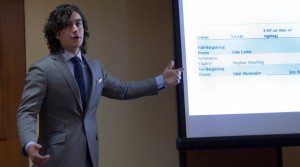 To the left, Senior Shane Piesik of Portsmouth, NH reverse-engineers the algorithm for calculating the pay for Major League Baseball pitchers. Shane found that the team strike-out to walk ratio (SOW) has become a key variable for determining revenues in recent seasons, so he then calculated the particular pitcher’s contribution to the team SOW to calculate the baseline marginal revenue product (and hence salary) of the pitcher. He found a premium for closers (they can handle the pressure), and for lefties (satisfying since he and I both are). It turns out that David Price actually deserves that 31 million dollar pay package (well, Shane calculated 30.798 million). Players who don’t have free agency are substantially underpaid. He also identified a few highly paid who could be earning much more–a sign they are truly dedicated to the home team. Thanks go to economic historian and baseball enthusiast Michael Haupert for his guidance through the literature. Photographer: Devin Reed.
To the left, Senior Shane Piesik of Portsmouth, NH reverse-engineers the algorithm for calculating the pay for Major League Baseball pitchers. Shane found that the team strike-out to walk ratio (SOW) has become a key variable for determining revenues in recent seasons, so he then calculated the particular pitcher’s contribution to the team SOW to calculate the baseline marginal revenue product (and hence salary) of the pitcher. He found a premium for closers (they can handle the pressure), and for lefties (satisfying since he and I both are). It turns out that David Price actually deserves that 31 million dollar pay package (well, Shane calculated 30.798 million). Players who don’t have free agency are substantially underpaid. He also identified a few highly paid who could be earning much more–a sign they are truly dedicated to the home team. Thanks go to economic historian and baseball enthusiast Michael Haupert for his guidance through the literature. Photographer: Devin Reed.
Academic Excellence 2015
To the left is senior Jesse Stephens presenting her econometrics project on campaign finance for the 2012 elections. She presented that also at the Eastern Economic Association in 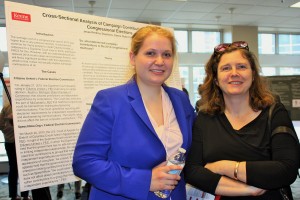 March and won the crowd–as did John Snider with his econometrics paper, Craving a Stogie?, and Ken Sullivan with his analysis of player productivity and basketball salaries. Their professor will miss the dickens out of them!
March and won the crowd–as did John Snider with his econometrics paper, Craving a Stogie?, and Ken Sullivan with his analysis of player productivity and basketball salaries. Their professor will miss the dickens out of them!
Boston 2013
On March 1 and 2, Seniors Ryan Young, Mike Grazewski, and Chris Hinchey will be presenting at the International Political Economy Undergraduate Sessions at the Boston Park Plaza Hotel. Ryan will be discussing how to end the student loan bubble, Mike will examine whether the bailout of the auto industry was wise, and Chris will explore by which mechanisms the Treaty of Versailles in 1919 caused hyperinflation in Germany in the early 1920s. If you are a current student who wants to be in the audience at that time, contact mduggan@keene.edu. Perhaps we will have dinner with some of our alum as well.
EASTERN ECONOMIC ASSOCIATION, Boston, 2012 
Ryan Young (KSC 2012) in conversation with Dr. Duncan Foley, President of the Eastern Economic Association.
 (Most of) the Keene State student contingent, Nathan Gray, Tyler Hall, Katie Morris, Alec Dutton, Sylvie McCarthy, Tim Reiss, Marie Duggan, and Mike Grazewski, departing from Boston Plaza Hotel.
(Most of) the Keene State student contingent, Nathan Gray, Tyler Hall, Katie Morris, Alec Dutton, Sylvie McCarthy, Tim Reiss, Marie Duggan, and Mike Grazewski, departing from Boston Plaza Hotel.
Ryan Young, Mike Grazewski, and Marie Duggan met the winner of the 2010 Nobel Prize, Dr. Peter Diamond (MIT). His work concerns labor market frictions, why its hard for job seekers and job openings to find each other. Rachel Battis (KSC 2011) wrote her senior thesis on that lit, and wasn’t I glad I had read her lit review so many times!
 Our alum Melissa Vaugh met us for dinner. Graduating from Keene State in 2004, Melissa got a master’s in personal finance from Bentley. Yes, this involved taking out a loan, but she credits that degree with helping her get the job she has as an operations manager for a hedge fund in Boston. Melissa at 30 is a lot like Melissa at 22 (intelligent, articulate, full of initiative), but more polished and sophisticated. Little known fact: she organized her entire sorrority to babysit for my baby in 2004.
Our alum Melissa Vaugh met us for dinner. Graduating from Keene State in 2004, Melissa got a master’s in personal finance from Bentley. Yes, this involved taking out a loan, but she credits that degree with helping her get the job she has as an operations manager for a hedge fund in Boston. Melissa at 30 is a lot like Melissa at 22 (intelligent, articulate, full of initiative), but more polished and sophisticated. Little known fact: she organized her entire sorrority to babysit for my baby in 2004.
 KSC alum Hannah Lique-Naitove also inspired us with her story of success. Despite graduating into the high unemployment rate of 2011, less than one year later, she is working as a junior analyst in Boston. Guess what? The boss read her senior research paper on why generation millenial finds it hard to save.
KSC alum Hannah Lique-Naitove also inspired us with her story of success. Despite graduating into the high unemployment rate of 2011, less than one year later, she is working as a junior analyst in Boston. Guess what? The boss read her senior research paper on why generation millenial finds it hard to save.
EQUILIBRATING MECHANISMS: THE INTELLECTUAL COMPANIONSHIP OF HUME AND SMITH, by Nathan Gray (below with Dr. Lopamudra Bannerjee (New School), his discussant).  How is Adam Smith’s theory of small-market equilibriumsimilar to David Hume’s theory of international-trade equilibrium? By comparing the forms and effects of Hume’s “price-specie-flow” mechanism with Smith’s “price-capitaladjustment” mechanism, this study shows how a shared focus on dynamic disequilibrium provided insights to each author that prompted them to converge in their specification of the forces that tend to promote equilibrium. The reasons for this convergence are elusive, however, since each theorist emphasized a different economic sphere and equilibrating variable: Hume’s model depicts international money movements affecting macro-level price fluctuations; Smith’s micro-level analysis shows productive capital allocations among industries compelling individual price fluctuations. The contribution of this paper lies in its explicit comparison of equilibrium and disequilibrium in the works of Hume and Smith, in contrast to the usual emphasis of economic historians on the dissimilarities and possible contentions between the two mechanisms and the philosophies of their respective authors.
How is Adam Smith’s theory of small-market equilibriumsimilar to David Hume’s theory of international-trade equilibrium? By comparing the forms and effects of Hume’s “price-specie-flow” mechanism with Smith’s “price-capitaladjustment” mechanism, this study shows how a shared focus on dynamic disequilibrium provided insights to each author that prompted them to converge in their specification of the forces that tend to promote equilibrium. The reasons for this convergence are elusive, however, since each theorist emphasized a different economic sphere and equilibrating variable: Hume’s model depicts international money movements affecting macro-level price fluctuations; Smith’s micro-level analysis shows productive capital allocations among industries compelling individual price fluctuations. The contribution of this paper lies in its explicit comparison of equilibrium and disequilibrium in the works of Hume and Smith, in contrast to the usual emphasis of economic historians on the dissimilarities and possible contentions between the two mechanisms and the philosophies of their respective authors.
Harvard Economic History Seminar Field Trip, Cambridge, 2012
Economic Historian Frank Lewis was speaking at Harvard about his work with Ann Carlos on the effects of the Hudson’s Bay fur trade on Indians near the Great Lakes. Keene State’s brainy seniors Sylvie McCarthy and Nathan Gray came with me to attend. Harvard’s economics department took us out to lunch first, where we met some rather young economic historians Nathan Nunn (African slave trade) and Eric Chaney (economics of the Middle East), as well as the eminent Stanley Engerman. Later we went over to Littauer Hall and heard the talk, with Claudia Goldin presiding. Afterwards, we chatted with a nice woman from Bentley College. We showed Sylvie the Charles River, and passed through the Harvard Coop, which had three rows of non-fiction economics through which to browse. Amazing that I only spent $40!
EASTERN ECONOMIC ASSOCIATION, New York, 2011
 Sylvie McCarthy, Malthusian Economics in Rwanda.
Sylvie McCarthy, Malthusian Economics in Rwanda.
What determines Rwanda’s gross domestic product? Ninety percent of Rwandans earn their livelihood from agriculture. Furthermore, Rwanda is the most densely populated country in Africa, and the country has been plagued by ethnic violence culminating in the genocide of 1994. Thomas Malthus suggested in 1798 that agricultural output grows more slowly than population. He predicted that the absence of checks on population growth would result in the population living in poverty as well as the possible emergence of violent conflict. Using regression analysis and data from the World Bank and the United Nations High Commissioner for Refugees, this paper analyzes the case of Rwanda to explore whether population growth has held back Rwanda’s economic growth, and the extent to which ethnic violence decimated the economy. The results of this analysis indicate that Malthus’s predictions were accurate in Rwanda’s case. This analysis contributes to our understanding of how a country should design policies to achieve economic stability.
 Katherine M. Morris, Are Newspapers Disappearing? The Demand for Print Edition Newspapers in the Ether of the Internet.
Katherine M. Morris, Are Newspapers Disappearing? The Demand for Print Edition Newspapers in the Ether of the Internet.
Are computers causing a decline in print subscriptions to newspapers? Decline in subscribers to many newspapers has introduced concern for the future existence of print edition newspapers. This question will be explored using data from our local southwestern New Hampshire paper, The Keene Sentinel. The Sentinel provides news to over 10,000 subscribers annually and has been in operation since 1799. The law of demand suggests that a rise in subscription price will cause a decrease in demand. Other factors that theory suggests capable of causing a reduction in demand include lower income, fall in population, rise in price of complements or fall in price of substitutes and changes in preferences. This paper will use regression analysis to explore the impact of price, population, percentage of population with internet access, and education attainment level on demand for the Keene Sentinel between 1970 and 2010. While the Keene Sentinel is smaller scale in comparison to large newspaper leaders, internet access have affected demand for papers across the country. This analysis can be used to help publishers respond to changing technology to so that newspapers can strategize best practices to thrive.
Rachael L. Battis, Unemployment trends and The Great Recession.
Why has our nation’s unemployment rate remained high despite signs that we are currently experiencing economic recovery? Arthur Okun explored the idea that there is a negative correlation between a nation’s GDP and a change in unemployment, in that as GDP increases (a sign of economic growth) unemployment will respectively decline. Okun’s law is more closely associated with a cyclical unemployment trend. While this is one explanation that has been explored, the idea of structural unemployment has also surfaced. In support of this, a production function is used in order to show the relationship between unemployment rates and job vacancies. It is the matching efficiency of these two variables that will later lead to new hires, and essentially lower unemployment. By exploring data provided by the Bureau of Labor Statistics and the St. Louis Federal Reserve both forms of unemployment trends have been explored in order to further understand their relationship to this most recent recession.
Hannah Lique-Naitove, Why Is Generation Millennial Reluctant to Save?
The Life Cycle Hypothesis predicts that young people will borrow and then save in middle age, finally borrowing again in retirement; the goal is to smooth consumption spending over time. Using data from the Consumer Expenditure Survey of the Bureau of Economic Analysis, we test the hypothesis that people born around 1990 are borrowing much earlier in life compared to earlier generations. This, coupled with the current high unemployment for new entrants to the labor force, suggests that financial planning will be more important for this generation than for previous generations. Yet Generation Millennial seems psychologically reluctant to prepare for the future.
 Joshua Tuliano, How Much Do Cigarette Tax Increases Improve the Public Health?
Joshua Tuliano, How Much Do Cigarette Tax Increases Improve the Public Health?
Research Question: How much do cigarette tax increases improve the public health?
Excise taxes are reduce smoking consumption, thus reducing smoking related diseases. However, Remler (2003) finds that lower income smokers who reduce cigarette consumption because of higher prices also reduce spending on nutritional food and healthcare to continue the smoking habit. This shows that although lower income individuals reduce cigarette consumption levels because of price barriers, their health may not improve from higher tax rates. Cigarette smoking is not purely elastic and higher income smokers reduce consumption when excise taxes increase because of a psychological benefit. Gruber & Mullainathan (2002) found that higher income smokers reduce consumption with higher costs because of opportunity cost. Using regressions, we find that clear air policies, higher excise taxes and public health awareness concerning cigarettes each play a role in reducing consumption. The data sets show that with improved health awareness and higher taxes, we can reduce smoking consumption and thus reduce smoking related mortality.
EASTERN ECONOMIC ASSOCIATION, Philadelphia 2010
 Evthoxia Kyroussis, Why do companies and individuals in Keene, NH come together to support the annual Pumpkin Festival, and what gains are received?
Evthoxia Kyroussis, Why do companies and individuals in Keene, NH come together to support the annual Pumpkin Festival, and what gains are received?
In 1991, the Pumpkin Festival began with the ambition of uniting the Keene community through downtown entertainment, and carving and illuminating pumpkins for everyone to enjoy. The Guiness Book of World Records in 1992 introduced the Pumpkin Festival to the world. Beginning as a community based event, tourism soon flooded the Keene festival. This paper examines why and how firms come together to support the festival, and what, if any, gains are received. The theory of social capital is used to explore the connection between collaboration among businesses and community economic development. Economists have criticized the theory for being vague, with no clear means of measuring social collaboration. Ms. Kyrousis conducted a survey of twenty-five randomly selected Main Street merchants to measure social cohesion and economic costs and benefits.
ACADEMIC EXCELLENCE 2010
A plethora of economics students presented their senior research papers at the 2010 Academic Excellence Conference at Keene State on March 27, 2010. Our seniors become professional economists right before the eyes of their families, peers and professors. Everyone remained cool under pressure.

Laura Demanche, The Impact of Economic Conditions on the Ski Sector in New Hampshire
What explains demand for skiing in New Hampshire? Is demand affected by economic downturns and booms? The limited economic literature on skier demand examines climate patterns, skier characteristics and regionally specific aspects, and this paper will fill the gap by examining the impact of economic conditions directly. The hypothesis is that demand is positively affected by snowfall and personal income, and negatively affected by unemployment. The hypothesis is tested by regressing snowfall in Boston and New York City, per capita personal income in Boston, and the US unemployment rate on total New Hampshire ski visits for 1983-2009. The findings indicate that snowfall and per capita personal income are statistically significant on the demand for skiing, while unemployment is not.

Samantha Rosendahl, Sturm Ruger and Newport, NH: A Relationship Built Upon Skill
Firearms manufacturer Sturm Ruger located in Newport, New Hampshire in 1963 in the Federal Tool building. Today Ruger is the largest employer in Newport. Why did Sturm Ruger decide to move to Newport, and could they suddenly leave? This paper explores the literature on Marshallian industrial location theory, and applies it to this case by exploring the skill base of machinists and the firearms industry in the Connecticut River Valley. I conclude that the existence of an industrial district played a role in drawing Ruger to Newport, but another important factor was Bill Ruger Sr.’s personal draw to the town. Data was gathered from a survey of forty Ruger employees, and suggests that a Marshallian industrial district still exists in the community today.

Marc Silano, Economic Considerations for Opening a Golf Course
Which type of golf course would be more profitable to build: private or public? The literature suggests that fee structure, location, maintenance expenditures, and environmental practices affect profitabilty. Mr. Silano predicted that a private course would make the highest profit. To test this, he sought maintenance spending data, but found that this was not publicly available. As a proxy, he examined the number of rounds played at private and public courses, and found that during economic downturns, private sector courses are adversely affected to a greater extent and for a longer duration than public courses. He concludes that opening a private course can be vialbe if preparations are made for economic downturns. He also found that building on a beautiful landscape, and building away from government-owned courses are critical factors for success.

Justin deMontigny, The Economic Viability of Geothermal Heating. Fall 2009.
Are geothermal heating systems a cost effective alternative to oil-burning systems? The question is whether installation costs can be recouped in a short enough period, given the high fixed costs. The hypothesis is that geothermal heating is a cost effective substitute to oil heat, given the rising price of oil and the environmental benefits. Data from industry sources and the Department of Energy illustrate the costs associated with each system (initial installation and operation). Mr. De Montigny examine how increases in the price of oil have lead to the adoption of geothermal systems through the substitution effect. The findings support the hypothesis.
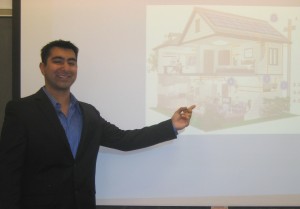
Nimit Palicha, How do Incentives Play a Role in the Consumer Decision to Choose Solar Energy in the State of New York?
Incentives may be granted to either the producer for research and development, or to the consumer in the form of rebates. Theory predicts that incentives to producers will lower costs more than incentives to consumers. The solar industry has used both. Mr. Palicha uses data from the Long Island Power Authority and the Department of Energy to illustrate that incentives to producers have brought down costs, which explains why consumers in Long Island have purchased greater quantities of solar energy even as rebates have declined. He concludes by exploring the transition from government to private sector financing that is currently taking place in solar energy.
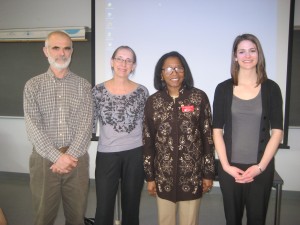
Evthoxia Kyrousis, Why do companies and individuals in Keene, NH come together to support the annual Pumpkin Festival, and what gains are received? In 1991, the Pumpkin Festival began with the ambition of uniting the Keene community through downtown entertainment, and carving and illuminating pumpkins for everyone to enjoy. The Guiness Book of World Records in 1992 introduced the Pumpkin Festival to the world. Beginning as a community based event, tourism soon flooded the Keene festival. This paper examines why and how firms come together to support the festival, and what, if any, gains are received. The theory of social capital is used to explore the connection between collaboration among businesses and community economic development. Economists have criticized the theory for being vague, with no clear means of measuring social collaboration. Ms. Kyrousis conducted a survey of twenty-five randomly selected Main Street merchants to measure social cohesion and economic costs and benefits.

Gino Frisella, Do Credit Cards Take Advantage of the Poor?
Do credit cards take particular advantage of poor people’s need for money, as the Scholastic economists argued in the 13th-15th centuries? My hypothesis is that credit card companies charge needier people higher interest rates. Interest rate data proved unavailable, so Mr. Frisella used late payments as a proxy. Credit cards make 30% of their profits from late payments. He used the 22,000 observations in the National Survey of Consumer Finances to explore whether characteristics such as being unemployed or having children increased the probability of a making a late payment. Through binomial logit maximum likelihood analysis, he concluded that the credit industry does take advantage of the neediest. This suggests reform of the industry is necessary.



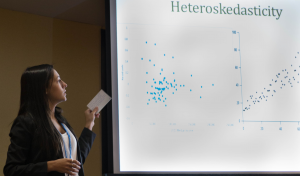


Thank you for making the AEC possible. We enjoyed the day.
I graduated from Keene in 2010, where a majored in Economics. After a lot of encouragement from Professor Duggan, I applied and was accepted to the UNH MA Economics program. I would encourage any Keene Economics students that are considering graduate school in the future to at least look into this program (or other programs too). It is a short (only 10 months) and very intense program, but I learned so much in that short time and felt that it was a really great opportunity. I would be more than happy to talk to any students from Keene if they have any questions about the program or graduate school in general (Professor Duggan has my contact information).
Enjoy the Eastern’s this year…such a great experience and good memories!